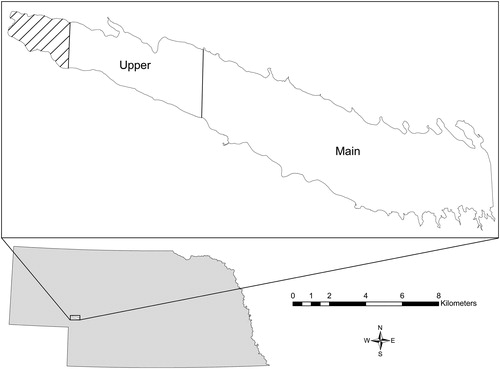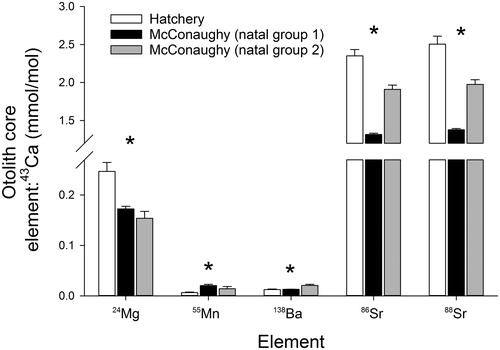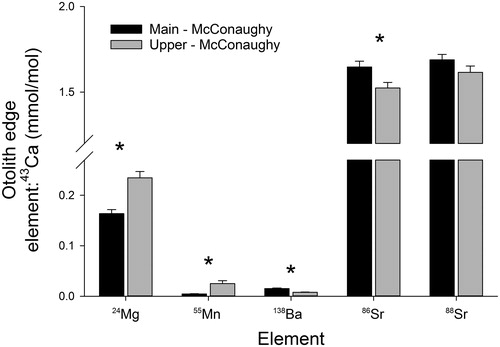Figures & data
Figure 1. Map of Lake McConaughy with designated upper and main sections of the reservoir based on physicochemical differences.

Figure 2. Visualizing differences (NMDS plot) among natal groups using 138Ba:43Ca, 24Mg:43Ca, 55Mn:43Ca, 86Sr:43Ca, and 88Sr:43Ca with hatchery fish (n = 17) in red, upward-facing triangles, McConaughy natal group 1 (n = 74) in green boxes, and McConaughy natal group 2 (n = 26) in blue, downward-facing triangles (with 95% confidence interval [CI] ellipses). Arrows represent underlying element:43Ca ratio differences (strength and direction).
![Figure 2. Visualizing differences (NMDS plot) among natal groups using 138Ba:43Ca, 24Mg:43Ca, 55Mn:43Ca, 86Sr:43Ca, and 88Sr:43Ca with hatchery fish (n = 17) in red, upward-facing triangles, McConaughy natal group 1 (n = 74) in green boxes, and McConaughy natal group 2 (n = 26) in blue, downward-facing triangles (with 95% confidence interval [CI] ellipses). Arrows represent underlying element:43Ca ratio differences (strength and direction).](/cms/asset/fbb97470-73e6-4ea5-bec6-30c3144e970b/ulrm_a_1637977_f0002_c.jpg)
Figure 3. Differences in 24Mg:43Ca, 55Mn:43Ca, 138Ba:43Ca, 86Sr:43Ca, and 88Sr:43Ca (from the otolith core) among 2 Lake McConaughy white bass natal groups (derived from cluster analysis) and hatchery fish. Differences assessed using a PERMANOVA and asterisks denote significant differences among groups (hatchery versus McConaughy natal groups) for each element:43Ca ratio.

Table 1. Predicted natal group assignment and accuracy (%) of white bass fingerlings collected from the North Platte Fish hatchery and age-0 white bass collected from Lake McConaughy (derived from cluster analysis) using otolith core ratios of 138Ba:43Ca, 24Mg:43Ca, 55Mn:43Ca, 86Sr:43Ca, and 88Sr:43Ca. We used 75% of the data to train the Random Forest model and used the remaining 25% of the data to measure the percent classification accuracy. Bold text indicates the number of fish and percentage (in parentheses) that were correctly assigned to their respective natal group.
Figure 4. Differences in 24Mg:43Ca, 55Mn:43Ca, 138Ba:43Ca, 86Sr:43Ca, and 88Sr:43Ca (from the otolith edge) between juvenile white bass collected from 2 sections of Lake McConaughy, Nebraska. Differences assessed using a PERMANOVA and asterisks denote significant differences between groups (upper versus main reservoir) for each element:43Ca ratio.

Table 2. Predicted lake section assignment and accuracy (%) of fish collected from the upper and main sections of Lake McConaughy using white bass otolith edge ratios of 24Mg:43Ca, 55Mn:43Ca, 138Ba:43Ca, and 86Sr:43Ca. We used 75% of the data to train the Random Forest model and used the remaining 25% of the data to measure the percent classification accuracy. Bold text indicates the number of fish and percentage (in parentheses) that were correctly assigned to their respective lake section.
